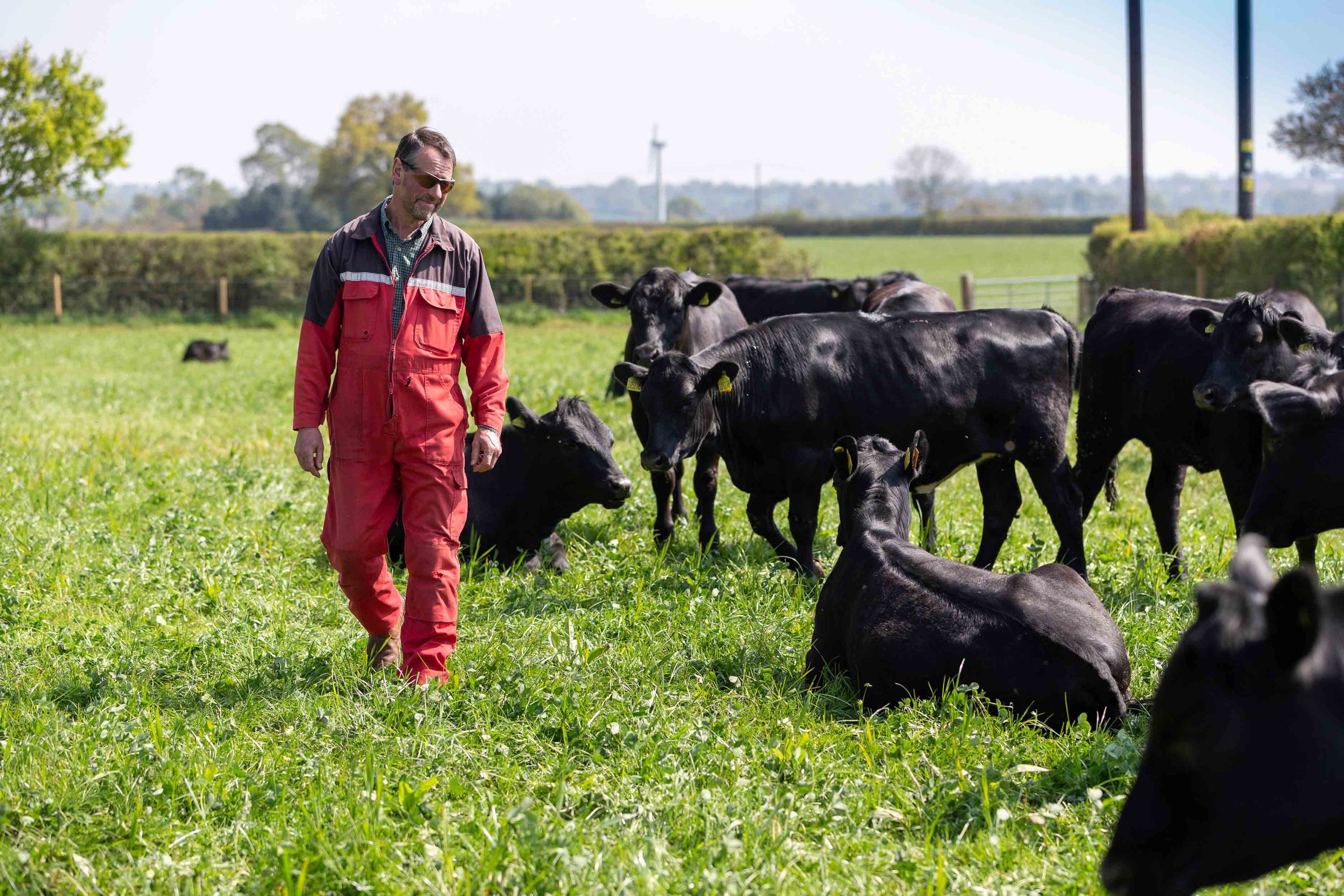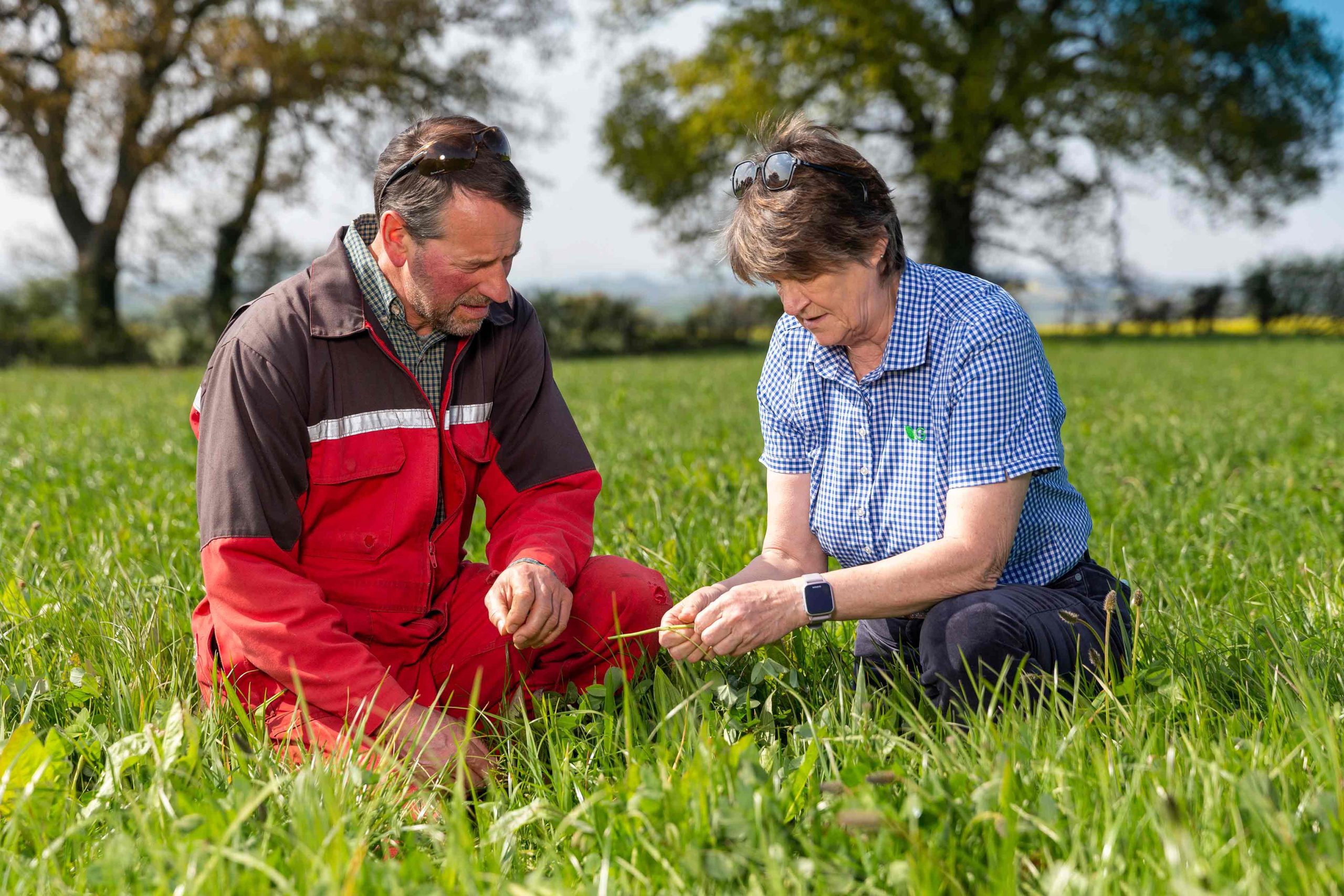The introduction of herbal leys, which are also known as multi-species swards, signals a major change in approach at Julian Bowers’ farm in Shropshire. Let’s learn what this transformation means for Top House Farm.
Farm facts: Top House Farm
- Around 200 Angus/Longhorn dairy crosses, plus a few remaining Friesian bulls grazing herbal leys
- 33ha (82 acres) GS4 herbal leys, drilled 10 August 2021
- Bespoke multi-species seed mix from Germinal to suit soil conditions
- 24 ha (60 acres) low-input spring cereals
- Remainder of land is short-term grass, some grown for haylage for a local stud farm
- Min till and no till approach
Not fearful of change
The Bowers family are not afraid to make changes to their farming business. Their current move away from intensive beef production to an extensive low-input system is the second significant shift for the former dairy farmers.
Having arrived at Top House Farm, Cockshutt, in 1997 the family settled into dairy production, milking 150 cows and growing maize and cereals. By 2010, when Julian’s parents wanted to retire, he and his brother knew they either needed to milk more cows and have staff to help, or leave dairying.
Embracing sustainable farming methods
They decided on the latter and looked for another opportunity for the 89 ha (220-acre) farm. This came along in the form of dairy bull calves, which they reared intensively in existing cattle sheds. Fast forward to 2021 and sustainable farming methods were becoming of more interest to Julian, so the time came for another change.
The calves required a lot of cereal-based feed to finish and spent their time on the farm indoors. “With prices beginning to go crazy, I was starting to think we were not sustainable as we were,” explains Julian. “I was thinking about how we can do better for the environment and for the animals.”
Drilling herbal leys for cattle
So, with the ‘safety net’ of a Countryside Stewardship Scheme agreement, he decided to drill 82 acres of herbal leys. This prompted a change from dairy bull calves to Angus and Longhorn crosses, which were better suited to grazing.
“They will finish outside without lots of cereals,” says Julian. “Those that do need to come in for the winter have silage rather than the corn-based diet we fed before.”
This means a much slower-maturing animal, but he believes it gives a better end product.
“It’s a premium grass-fed beef animal now and you can’t do much better than that. Plus, it is nice to see cattle outside grazing – the visual aspect is so much better.”
Reducing inputs with multi-species
Herbal leys provide a complete food for the cattle and have enabled a reduction in all inputs, which is a big positive for Julian.
“Our stewardship agreement covers the herbal leys, plus low-input spring cereals and winter cover crops. I’m looking to use a lot less chemical of any description.” This includes wormers as herbal leys have natural anthelmintic properties.
“Hopefully the leys have four to five years’ life in them while keeping within the GS4 rules of no artificial fertilisers or sprays.” Instead, manure from grazing cattle plus some liquid digestate will be enough to maintain fertility, he says.
Managing herbal leys
Drilled in August 2021, the multi-species leys were established with a min till or no till approach. “One of the three fields was lightly disced first, and we had a contractor direct drill the others.” Establishment was good, he says.
By winter, one field had a chickweed problem, so Julian enlisted the help of a local sheep producer whose flock grazed the field for him.
“It gave the crop the chance to be more competitive with the chickweed, which is quite a strangling weed and seems to do most of its damage over winter.” The other fields were just lightly grazed by cattle in the autumn months.
Preferred herbal ley seed mix
The seed used is a bespoke GS4 herbal ley mix, explains Julian. “I’ve known Helen Mathieu from Germinal for many years and told her what I wanted to achieve. She suggested that because we have quite heavy soil here, a bespoke mix would be best.”
The mixture includes five different grasses, three clovers, plantain, chicory and birdsfoot trefoil. Lucerne and sanfoin were left out as they both prefer lighter land.
Moving to multi-species leys has required a mindset change too, he explains. “We were used to monocrops and seeing consistency across the field, not the variety and diversity we have now.”
His working day is different too, with time spent moving electric fencing and checking stock rather than feeding from a tractor. Fuel use has reduced with the telehandler, straw chopper and feeder wagon clocking up far fewer hours over the year.
Sustainable with fewer inputs, lower costs and a premium product
“I’m really pleased with the herbal ley. It has established well and had a great start this spring,” says Julian. “We have changed massively in the past 12 months. Our new approach is giving us the opportunity to continue farming in a more sustainable way, spending less money on inputs while producing a premium product.”
Originally published in Forager Magazine from Germinal – Summer 2022 Beef & Sheep edition
Talk to the grass and forage seed experts


